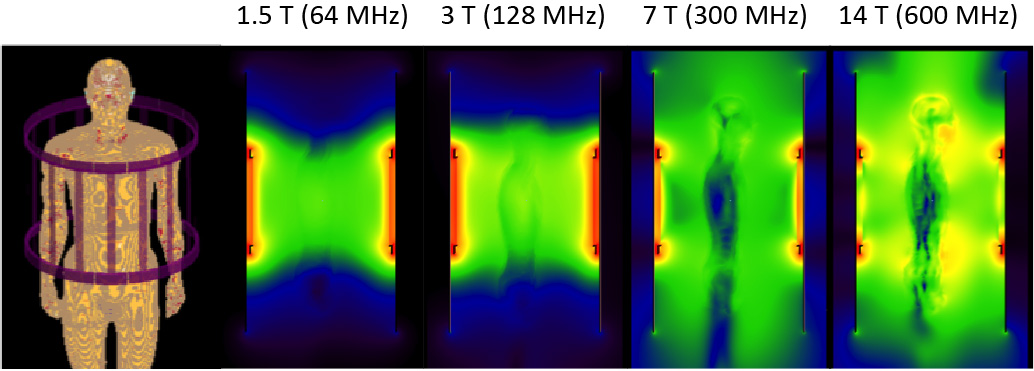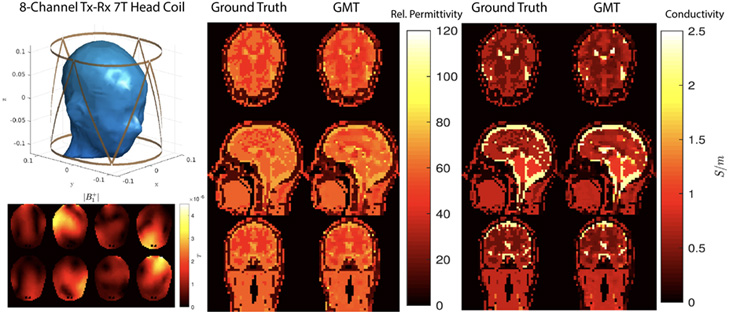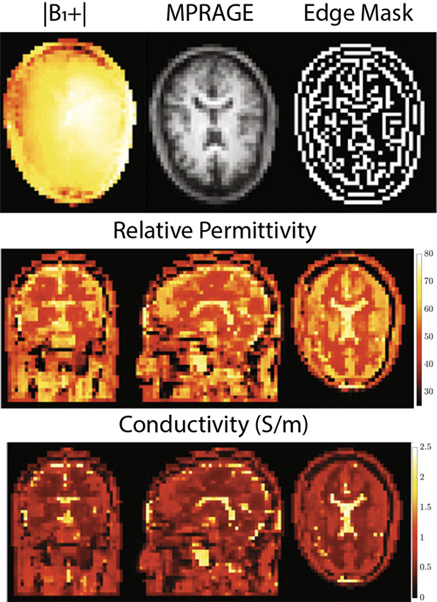Noninvasive Estimation of Electrical Properties from Magnetic Resonance Measurements

Overview
In this project we pursue a three-pronged research strategy to obtain accurate maps of the electrical properties of biological tissue.
The electrical properties (EP) of biological tissue, namely electric conductivity and relative permittivity, provide quantitative information that has the potential to advance technical, medical, and scientific applications of MRI. These include: more precise transmission and detection of radiofrequency (RF) waves; provision of insights needed to solve the problem of magnetic field inhomogeneity; personalized estimation of RF power specific absorption rate (SAR); better detection of cancer; improved RF ablation and hyperthermia; and discovery of new knowledge about the structure and function of living tissue. However, despite decades of research, EP tissue mapping remains an unsolved problem.
Magnetic resonance, which can provide tomographic measurements that reflect the curvature of the electromagnetic field inside an object, is a promising tool for robust EP estimation. Our goal is to use previously untapped properties of RF coils already integral in MRI to measure electrical properties of tissue at high spatial resolution.
Our strategy comprises three different approaches. First, we solve a global inverse problem by using the integral form of Maxwell’s equations. To this end, we have introduced global Maxwell tomography (GMT), a technique for three-dimensional noninvasive EP estimation from MR measurements. Second, we implement a physics-informed neural network that solves the differential form of Maxwell’s equations. Our method, called physics-informed Fourier networks for electrical properties tomography (PIFON-EPT), estimates EP and magnetic transmit field distributions from noisy or incomplete MR measurements. Third, we have developed a supervised neural network based on a 3D vision transformer to reconstruct EP from MR measurements obtained with a birdcage coil. We are pursuing further development of these techniques with the aim of creating spatially-resolved maps of the electrical conductivity and permittivity of tissue in vivo.
Keywords
- MRI
- Electrical Property Tomography
- Computational Electromagnetics

Figure 1. Simulated EP reconstructions using GMT for a realistic numerical head model. We modeled an 8-channel transmit-receive 7T head coil and minimized the difference between synthetically generated noisy measurements of the coils’ transmit fields and the transmit fields estimated using updated guesses of EP during the iterative GMT inverse problem solution. The reconstructed EP closely matched the ground truth EP.

Figure 2. In vivo EP reconstructions using a neural network based on a 3D vision transformer. Electric conductivity and relative permittivity maps of a human head were estimated from the MR measurements obtained with a birdcage coil at 3T. The input included an edge mask obtained from a 3D MPRAGE image to help preserving boundaries between relevant anatomical structures.
Project Team

Riccardo Lattanzi, PhD
Project Lead
External Collaborators
- Luca Dal Negro, PhD, Boston University
- Zheng Zhang, PhD, University of California, Santa Barbara
Publications
- Giannakopoulos II, Carluccio G, Keerthivasan MB, Koerzdoerfer G, Lakshmanan K, De Moura HL, Cruz Serrallés JE and Lattanzi R, MR electrical properties mapping using vision transformers and canny edge detectors; Magnetic Resonance in Medicine, vol 93(3), 2025, p. 1117-1131. (Editor’s pick) doi: 10.1002/mrm.30338
- Yu X, Serrallés JEC, Giannakopoulos II, Liu Z, Daniel L, Lattanzi R and Zhang Z, PIFON-EPT: MR-Based Electrical Property Tomography Using Physics-Informed Fourier Networks; IEEE Journal on Multiscale and Multiphysics Computational Techniques (JMMCT), vol 9, 2024, p. 49-60. doi:10.1109/JMMCT.2023.3345798
- Giannakopoulos II, Serrallés JEC, Daniel L, Sodickson DK, Polimeridis AG, White JK and Lattanzi R, Magnetic-resonance-based electrical property mapping using Global Maxwell Tomography with an 8-channel head coil at 7 Tesla: a simulation study; IEEE Transactions on Biomedical Engineering, vol 68(1), 2021, p. 236-246. doi: 10.1109/TBME.2020.2991399
- Serrallés J, Zhang B, Ianniello C, Cloos MA, Polimeridis A, White JK, Sodickson DK, Daniel L and Lattanzi R, Noninvasive estimation of electrical properties from magnetic resonance measurements via Global Maxwell Tomography and Match Regularization; IEEE Transactions on Biomedical Engineering, vol 67(1), 2020, p. 3-15. doi: 10.1109/TBME.2019.2907442
Acknowledgements
This research project has been partially supported by the National Science Foundation (NSF) under Award NSF CAREER 1453675, and National Institutes of Health (NIH) under Award Number P41 EB017183.





